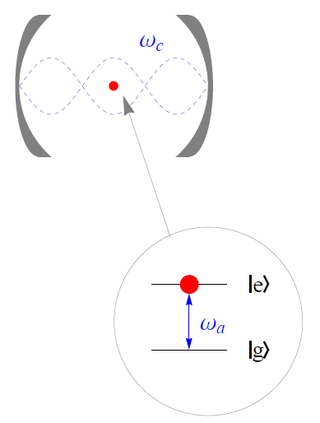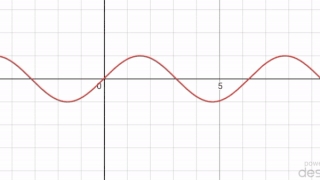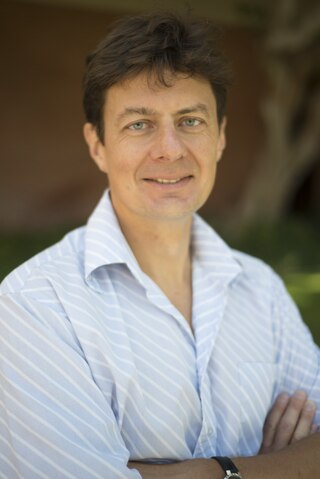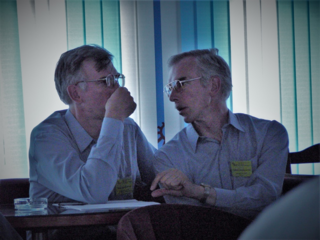
Quantum mechanics is a fundamental theory in physics that describes the behavior of nature at and below the scale of atoms. It is the foundation of all quantum physics, which includes quantum chemistry, quantum field theory, quantum technology, and quantum information science.
Spontaneous emission is the process in which a quantum mechanical system transits from an excited energy state to a lower energy state and emits a quantized amount of energy in the form of a photon. Spontaneous emission is ultimately responsible for most of the light we see all around us; it is so ubiquitous that there are many names given to what is essentially the same process. If atoms are excited by some means other than heating, the spontaneous emission is called luminescence. For example, fireflies are luminescent. And there are different forms of luminescence depending on how excited atoms are produced. If the excitation is effected by the absorption of radiation the spontaneous emission is called fluorescence. Sometimes molecules have a metastable level and continue to fluoresce long after the exciting radiation is turned off; this is called phosphorescence. Figurines that glow in the dark are phosphorescent. Lasers start via spontaneous emission, then during continuous operation work by stimulated emission.

Ionization is the process by which an atom or a molecule acquires a negative or positive charge by gaining or losing electrons, often in conjunction with other chemical changes. The resulting electrically charged atom or molecule is called an ion. Ionization can result from the loss of an electron after collisions with subatomic particles, collisions with other atoms, molecules, electrons, positrons, protons, antiprotons and ions, or through the interaction with electromagnetic radiation. Heterolytic bond cleavage and heterolytic substitution reactions can result in the formation of ion pairs. Ionization can occur through radioactive decay by the internal conversion process, in which an excited nucleus transfers its energy to one of the inner-shell electrons causing it to be ejected.
The Wheeler–Feynman absorber theory, named after its originators, the physicists Richard Feynman and John Archibald Wheeler, is a theory of electrodynamics based on a relativistic correct extension of action at a distance electron particles. The theory postulates no independent electromagnetic field. Rather, the whole theory is encapsulated by the Lorentz-invariant action of particle trajectories defined as
The Bose–Hubbard model gives a description of the physics of interacting spinless bosons on a lattice. It is closely related to the Hubbard model that originated in solid-state physics as an approximate description of superconducting systems and the motion of electrons between the atoms of a crystalline solid. The model was introduced by Gersch and Knollman in 1963 in the context of granular superconductors. The model rose to prominence in the 1980s after it was found to capture the essence of the superfluid-insulator transition in a way that was much more mathematically tractable than fermionic metal-insulator models.

The Jaynes–Cummings model is a theoretical model in quantum optics. It describes the system of a two-level atom interacting with a quantized mode of an optical cavity, with or without the presence of light. It was originally developed to study the interaction of atoms with the quantized electromagnetic field in order to investigate the phenomena of spontaneous emission and absorption of photons in a cavity.
Car–Parrinello molecular dynamics or CPMD refers to either a method used in molecular dynamics or the computational chemistry software package used to implement this method.

The Landau–Zener formula is an analytic solution to the equations of motion governing the transition dynamics of a two-state quantum system, with a time-dependent Hamiltonian varying such that the energy separation of the two states is a linear function of time. The formula, giving the probability of a diabatic transition between the two energy states, was published separately by Lev Landau, Clarence Zener, Ernst Stueckelberg, and Ettore Majorana, in 1932.

Joseph Henry Eberly is an American physicist who holds the positions of Andrew Carnegie Professor of Physics and Astronomy and Professor of Optics at the University of Rochester.
Quantum dissipation is the branch of physics that studies the quantum analogues of the process of irreversible loss of energy observed at the classical level. Its main purpose is to derive the laws of classical dissipation from the framework of quantum mechanics. It shares many features with the subjects of quantum decoherence and quantum theory of measurement.
The timeline of quantum mechanics is a list of key events in the history of quantum mechanics, quantum field theories and quantum chemistry.
Circuit quantum electrodynamics provides a means of studying the fundamental interaction between light and matter. As in the field of cavity quantum electrodynamics, a single photon within a single mode cavity coherently couples to a quantum object (atom). In contrast to cavity QED, the photon is stored in a one-dimensional on-chip resonator and the quantum object is no natural atom but an artificial one. These artificial atoms usually are mesoscopic devices which exhibit an atom-like energy spectrum. The field of circuit QED is a prominent example for quantum information processing and a promising candidate for future quantum computation.

In quantum mechanics, the quantum revival is a periodic recurrence of the quantum wave function from its original form during the time evolution either many times in space as the multiple scaled fractions in the form of the initial wave function or approximately or exactly to its original form from the beginning. The quantum wave function periodic in time exhibits therefore the full revival every period. The phenomenon of revivals is most readily observable for the wave functions being well localized wave packets at the beginning of the time evolution for example in the hydrogen atom. For Hydrogen, the fractional revivals show up as multiple angular Gaussian bumps around the circle drawn by the radial maximum of leading circular state component of the original localized state and the full revival as the original Gaussian. The full revivals are exact for the infinite quantum well, harmonic oscillator or the hydrogen atom, while for shorter times are approximate for the hydrogen atom and a lot of quantum systems.
In theoretical physics, a mass generation mechanism is a theory that describes the origin of mass from the most fundamental laws of physics. Physicists have proposed a number of models that advocate different views of the origin of mass. The problem is complicated because the primary role of mass is to mediate gravitational interaction between bodies, and no theory of gravitational interaction reconciles with the currently popular Standard Model of particle physics.

The Jaynes–Cummings–Hubbard (JCH) model is a many-body quantum system modeling the quantum phase transition of light. As the name suggests, the Jaynes–Cummings–Hubbard model is a variant on the Jaynes–Cummings model; a one-dimensional JCH model consists of a chain of N coupled single-mode cavities, each with a two-level atom. Unlike in the competing Bose–Hubbard model, Jaynes–Cummings–Hubbard dynamics depend on photonic and atomic degrees of freedom and hence require strong-coupling theory for treatment. One method for realizing an experimental model of the system uses circularly-linked superconducting qubits.

In mathematics, a periodic travelling wave is a periodic function of one-dimensional space that moves with constant speed. Consequently, it is a special type of spatiotemporal oscillation that is a periodic function of both space and time.

Oleg V. Prezhdo is a Ukrainian–American physical chemist whose research focuses on non-adiabatic molecular dynamics and time-dependent density functional theory (TDDFT). His research interests range from fundamental aspects of semi-classical and quantum-classical physics to excitation dynamics in condensed matter and biological systems. His research group focuses on the development of new theoretical models and computational tools aimed at understanding chemical reactivity and energy transfer at a molecular level in complex condensed phase environment. Since 2014, he is a professor of chemistry and of physics & astronomy at the University of Southern California.

Carlos Ray Stroud, Jr. is an American physicist and educator. Working in the field of quantum optics, Stroud has carried out theoretical and experimental studies in most areas of the field from its beginnings in the late 1960s, studying the fundamentals of the quantum mechanics of atoms and light and their interaction. He has authored over 140 peer-reviewed papers and edited seven books. He is a fellow of the American Physical Society and the Optical Society of America, as well as a Distinguished Traveling Lecturer of the Division of Laser Science of the American Physical Society. In this latter position he travels to smaller colleges giving colloquia and public lectures.
The Dicke model is a fundamental model of quantum optics, which describes the interaction between light and matter. In the Dicke model, the light component is described as a single quantum mode, while the matter is described as a set of two-level systems. When the coupling between the light and matter crosses a critical value, the Dicke model shows a mean-field phase transition to a superradiant phase. This transition belongs to the Ising universality class and was realized in cavity quantum electrodynamics experiments. Although the superradiant transition bears some analogy with the lasing instability, these two transitions belong to different universality classes.

Vladimir Kocharovsky is a Russian physicist, academic and researcher. He is a Head of the Astrophysics and Space Plasma Physics Department at the Institute of Applied Physics of the Russian Academy of Sciences and a professor at N.I. Lobachevsky State University of Nizhny Novgorod.









